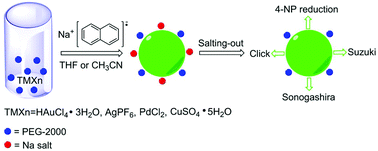当前位置:
X-MOL 学术
›
Inorg. Chem. Front.
›
论文详情
Our official English website, www.x-mol.net, welcomes your feedback! (Note: you will need to create a separate account there.)
Synthesis of late transition-metal nanoparticles by Na naphthalenide reduction of salts and their catalytic efficiency†
Inorganic Chemistry Frontiers ( IF 7 ) Pub Date : 2017-10-13 00:00:00 , DOI: 10.1039/c7qi00530j Fangyu Fu 1, 2, 3, 4, 5 , Angel M. Martinez-Villacorta 6, 7, 8, 9 , Ane Escobar 6, 7, 8, 9 , Joseba Irigoyen 6, 7, 8, 9 , Sergio Moya 6, 7, 8, 9 , Eric Fouquet 1, 2, 3, 4, 5 , Jaime Ruiz 1, 2, 3, 4, 5 , Didier Astruc 1, 2, 3, 4, 5
Inorganic Chemistry Frontiers ( IF 7 ) Pub Date : 2017-10-13 00:00:00 , DOI: 10.1039/c7qi00530j Fangyu Fu 1, 2, 3, 4, 5 , Angel M. Martinez-Villacorta 6, 7, 8, 9 , Ane Escobar 6, 7, 8, 9 , Joseba Irigoyen 6, 7, 8, 9 , Sergio Moya 6, 7, 8, 9 , Eric Fouquet 1, 2, 3, 4, 5 , Jaime Ruiz 1, 2, 3, 4, 5 , Didier Astruc 1, 2, 3, 4, 5
Affiliation

|
The investigation of new methods of facile synthesis of salt-free, catalytically efficient nanoparticles is challenging. Pd, Cu, Ag and Au nanoparticles (NPs) have been synthesized here by Na naphthalenide reduction of commercial transition-metal salts in THF or MeCN in the presence of poly(ethylene glycol). These NPs have been characterized by UV-vis. and XPS spectroscopy showing the presence of zero-valent metals and by TEM showing their small sizes. They have been purified by double extraction benefiting from the salting-out effect. The catalytic properties of these NPs have been compared for the classic 4-nitrophenol reduction by excess NaBH4. The small Pd and Au NPs (1.7 resp. 2.0 nm) are the most efficient catalysts without retention times for this reaction, whereas Cu and Ag nanoparticles that are larger (3.3 resp. 4 nm) showed retention times and lower rate constants. NPs purified by the salting-out effect were more efficient than non-purified ones. PdNPs were also very active catalysts for the Suzuki–Miyaura reaction between bromobenzene and phenylboronic acid (95% yield with 100 ppm Pd) and for the Sonogashira reaction between phenyl acetylene and iodobenzene. CuNPs reported using this method were more efficient “click” catalysts as Cu2ONPs, and these NPs were used in organometallic “click” synthesis and Sonogashira co-catalysis. For the latter PdNP-catalyzed reaction, the yield was slightly improved in the presence of supported Cu2ONP on SBA-15 (90% vs. 81%). Supporting the PdNP catalyst on SBA-15 even proceeded without a large NP size change, provided improved reaction yields and afforded several recycling cycles without significant Pd leaching.
中文翻译:

萘二甲酸钠盐还原反应合成晚期过渡金属纳米粒子及其催化效率†
易于合成无盐,催化效率高的纳米颗粒的新方法的研究具有挑战性。Pd,Cu,Ag和Au纳米粒子(NPs)在这里是通过萘二甲萘在聚乙二醇存在下在THF或MeCN中还原商用过渡金属盐而合成的。这些NP已经通过UV-vis表征。和XPS光谱显示零价金属的存在,而TEM则显示它们的小尺寸。它们已通过双重萃取纯化,得益于盐析作用。比较了这些NP的催化特性,以比较经典的4-硝基苯酚被过量的NaBH 4还原。较小的Pd和Au NPs(1.7到2.0 nm)是最有效的催化剂,没有该反应的保留时间,而较大的Cu和Ag纳米颗粒(3.3到4 nm)则显示出保留时间和较低的速率常数。通过盐析作用纯化的NP比未纯化的NP更有效。对于溴苯和苯基硼酸之间的Suzuki-Miyaura反应(100 ppm Pd的产率为95%)和苯基乙炔与碘代苯之间的Sonogashira反应,PdNP也是非常活泼的催化剂。据报道,使用这种方法的CuNPs是更有效的“点击”催化剂,如Cu 2 ONPs,这些NPs用于有机金属“点击”合成和Sonogashira共催化。对于后一种PdNP催化的反应,在负载型Cu的存在下收率略有提高SBA-15上的2个ONP(分别为90%和81%)。即使在没有较大NP尺寸变化的情况下,也可以在SBA-15上负载PdNP催化剂,提高了反应产率,并提供了几个循环周期,而没有明显的Pd浸出。
更新日期:2017-10-13
中文翻译:

萘二甲酸钠盐还原反应合成晚期过渡金属纳米粒子及其催化效率†
易于合成无盐,催化效率高的纳米颗粒的新方法的研究具有挑战性。Pd,Cu,Ag和Au纳米粒子(NPs)在这里是通过萘二甲萘在聚乙二醇存在下在THF或MeCN中还原商用过渡金属盐而合成的。这些NP已经通过UV-vis表征。和XPS光谱显示零价金属的存在,而TEM则显示它们的小尺寸。它们已通过双重萃取纯化,得益于盐析作用。比较了这些NP的催化特性,以比较经典的4-硝基苯酚被过量的NaBH 4还原。较小的Pd和Au NPs(1.7到2.0 nm)是最有效的催化剂,没有该反应的保留时间,而较大的Cu和Ag纳米颗粒(3.3到4 nm)则显示出保留时间和较低的速率常数。通过盐析作用纯化的NP比未纯化的NP更有效。对于溴苯和苯基硼酸之间的Suzuki-Miyaura反应(100 ppm Pd的产率为95%)和苯基乙炔与碘代苯之间的Sonogashira反应,PdNP也是非常活泼的催化剂。据报道,使用这种方法的CuNPs是更有效的“点击”催化剂,如Cu 2 ONPs,这些NPs用于有机金属“点击”合成和Sonogashira共催化。对于后一种PdNP催化的反应,在负载型Cu的存在下收率略有提高SBA-15上的2个ONP(分别为90%和81%)。即使在没有较大NP尺寸变化的情况下,也可以在SBA-15上负载PdNP催化剂,提高了反应产率,并提供了几个循环周期,而没有明显的Pd浸出。



























 京公网安备 11010802027423号
京公网安备 11010802027423号